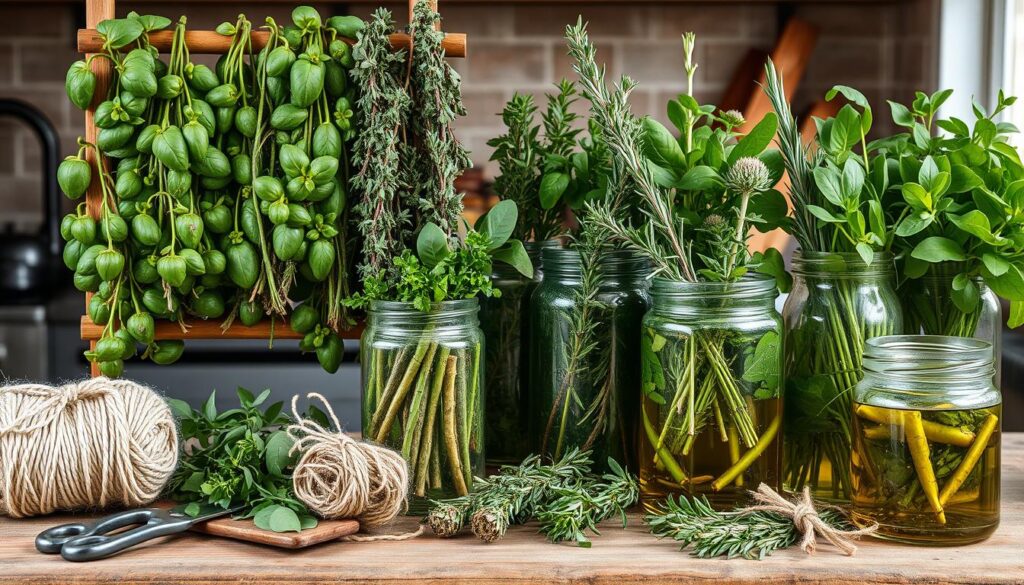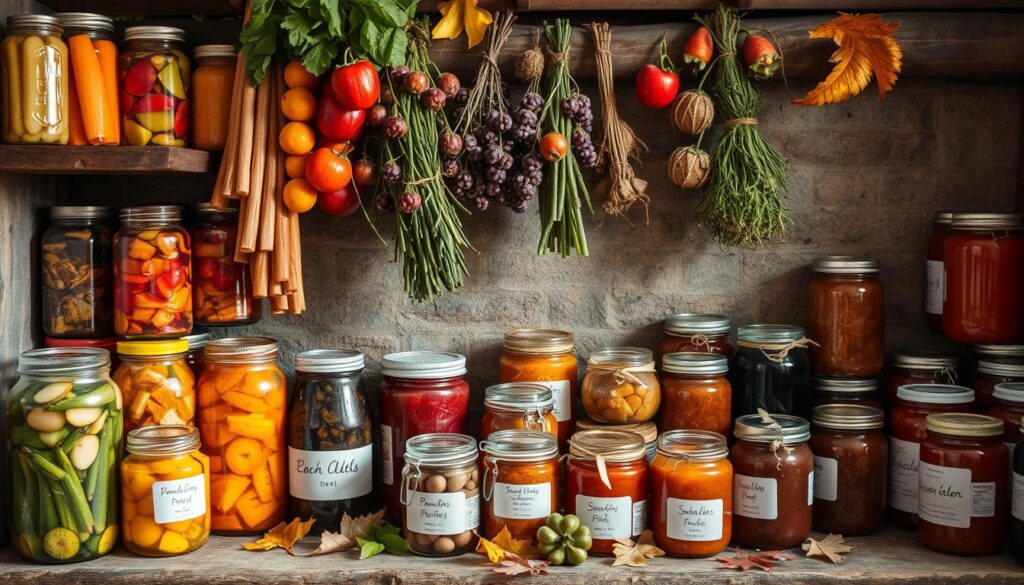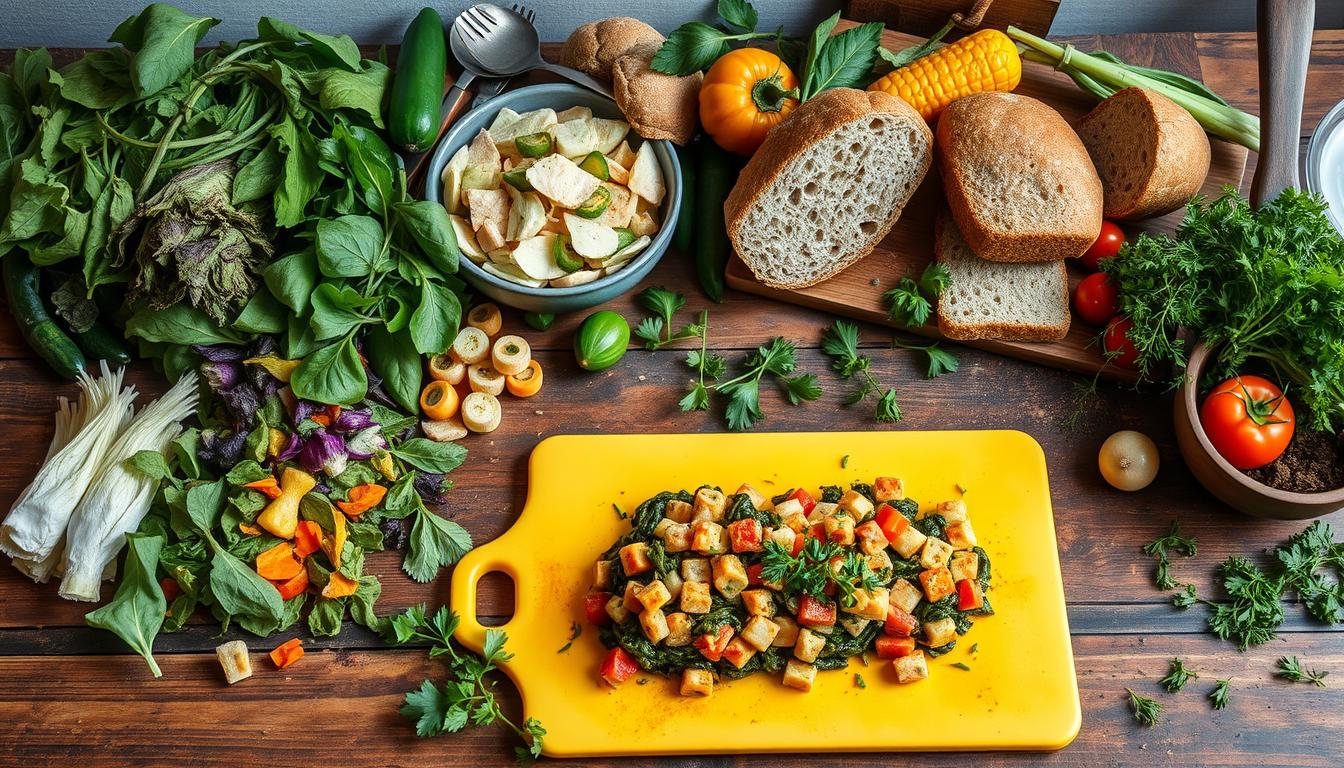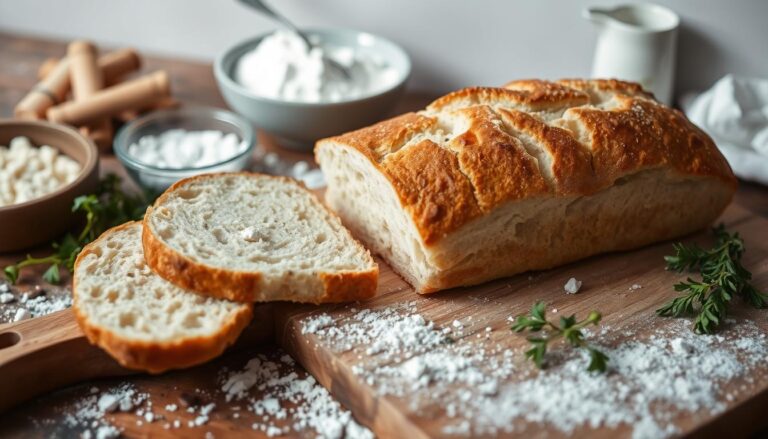Discard Recipes: Tasty Ways to Use Up Leftover Ingredients
Every time I opened my fridge, I felt guilty. Wilting veggies, half-used containers, and forgotten ingredients stared back. They were silent reminders of wasted food. But then, I found the art of making discard recipes.
This changed my kitchen. I started using kitchen scraps to make new dishes. It saved money and made me love cooking again.
Waste reduction ideas are more than a trend. They’re a way to make your kitchen better. You can make crispy crackers from sourdough starter or delicious baked treats from overripe bananas.
Cooking sustainably is about being creative and resourceful. It’s about turning kitchen waste into tasty meals that surprise and delight.
Table of Contents
Understanding Food Waste and Its Environmental Impact
Food waste is a big problem in American homes, affecting the environment and our wallets. What you do in your kitchen can help solve this issue. The U.S. throws away 30-40% of all food produced, causing big environmental and financial problems.
The Cost of Kitchen Waste in American Households
Zero waste kitchen recipes are essential, not just a trend. The cost of food waste is huge:
- Billions of dollars lost each year from food thrown away
- Big impact on household budgets
- Waste in production and transport
Environmental Benefits of Reducing Food Waste
Choosing to cook in an eco-friendly way can cut down your carbon footprint. The benefits include:
- Less methane from food rotting in landfills
- Lower greenhouse gas emissions
- Less waste in farming
“Every meal you save is a step towards a more sustainable planet.” – EPA Sustainability Report
Building a Sustainable Kitchen Practice
The goal to cut food loss by 50% by 2030 needs everyone’s help. Programs like the $5 billion Climate Pollution Reduction Grants show we’re serious about green food systems. By making smart choices, you can help achieve this important goal.
Your actions count. By using zero waste kitchen recipes and cooking mindfully, you can make your kitchen greener. This helps reduce waste and use resources better.
Essential Tips for Smart Ingredient Storage
Keeping your ingredients fresh is key to reducing waste and making eco-friendly recipes. Your kitchen can become super efficient with smart storage. This helps keep food fresh longer and cuts down on waste.
Smart storage starts with knowing how ingredients react to their environment. Air, moisture, and light can make food go bad fast. By using the right storage, you can keep your ingredients fresh longer and make the most of your recipes.
Pantry Organization Strategies
- Use airtight containers for dry goods like flour, sugar, and grains
- Implement the FIFO (First In, First Out) method to use older items first
- Label containers with purchase or opening dates
- Organize items at eye level for easy accessibility
- Keep backup stocks of frequently used ingredients
Pro tip: Digital scales can help you precisely measure and track ingredient quantities, reducing waste.
Refrigerator Storage Zones
Your fridge is more than just a cold place—it’s a smart storage system. It has different zones for different temperatures:
- Top shelves: Ready-to-eat foods
- Middle shelves: Dairy and leftovers
- Bottom shelves: Raw meats
- Drawers: Fruits and vegetables with controlled humidity
“Proper storage isn’t just about preservation—it’s about respecting the ingredients and reducing environmental impact.” – Sustainable Kitchen Experts
By using these smart storage tips, you’ll turn your kitchen into a waste-reducing, eco-friendly space. It will support your cooking creativity and care for the planet.
Creative Ways to Use Leftover Fruits
Turning overripe fruits into tasty dishes is a great way to reduce waste. Instead of throwing away fruits that seem too ripe, you can make them into fun meals. This saves money and cuts down on food waste.
Americans throw away almost $2,000 worth of food each year. Fruits are a big part of this waste. By using easy recipes, you can greatly reduce kitchen waste and make yummy dishes.
Overripe Banana Transformations
Bananas getting brown? Don’t throw them away! They’re great for many recipes:
- Banana bread with nuts or chocolate chips
- Smoothies with a creamy texture
- Frozen banana “nice cream”
- Moist muffins packed with flavor
Citrus Fruit Solutions
Citrus fruits can be used in many ways:
- Create zesty marinades
- Brew refreshing infused waters
- Make homemade salad dressings
- Prepare citrus-based sauces
Stone Fruit and Berry Ideas
Stone fruits and berries are very versatile. About 40% of overripe fruits can be turned into tasty treats like:
- Roasted peaches with honey
- Berry compotes
- Fruit sorbets
- Grape and mango salsas
“Waste not, want not” – A timeless kitchen philosophy that saves money and reduces environmental impact.
By using these creative ideas, you’ll cut down on food waste. You’ll also find new recipes that make old fruits seem new again.
Vegetable Scraps and Their Hidden Potential
Did you know 40% of food we buy ends up in the trash? Your kitchen scraps are full of nutrition and flavor. They can be turned into delicious dishes that reduce waste and make the most of your ingredients.
Turning vegetable scraps into food is not just smart—it’s good for the planet. It helps cut down on food waste, which is a big contributor to greenhouse gases. It’s even more than the emissions from the entire airline industry.
“One person’s trash is another person’s culinary masterpiece.” – Anonymous Chef
Creative Ways to Use Vegetable Scraps
- Create homemade vegetable stock using carrot tops, celery ends, and onion skins
- Blend beetroot leaves into nutrient-dense smoothies
- Roast broccoli stems for crispy side dishes
- Use potato peels for savory chip alternatives
With sustainable cooking tips, you can make your kitchen waste into gourmet dishes. Here are some creative ways to start:
| Vegetable Scrap | Recommended Use |
|---|---|
| Carrot Tops | Pesto, garnish, herb mix |
| Broccoli Stems | Stir-fry, slaw, roasted chips |
| Beetroot Leaves | Salad greens, sautéed side dish |
Pro tip: Always wash your vegetable scraps thoroughly before repurposing to ensure food safety and maximize nutritional value.
Mastering Discard Recipes for Baking Success
Turning kitchen waste into tasty treats is key in zero waste kitchen recipes. Sourdough discard, often seen as waste, can be a treasure. It makes your baking better and cuts down on food waste.
Bakers usually throw away 80% of their starter. But these leftovers are full of possibilities for easy recipes. They have flour and water, making them rich in nutrients for baking.
Sourdough Discard Innovations
Sourdough discard brings many benefits to baking:
- Breaks down phytic acid, improving nutrient absorption
- Adds moisture to baked goods
- Contributes to a tender crumb structure
- Supports gut health through prebiotic content
Quick Bread and Muffin Ideas
Try your discard in different recipes, like banana nut muffins or hearty quick breads. The fermentation adds complex flavors and better texture.
| Baking Item | Discard Impact |
|---|---|
| Brownies | Creates moist, dense texture |
| Pancakes | Adds tangy flavor and lightness |
| Cookies | Enhances moisture and depth |
Creative Pastry Solutions
Your sourdough discard can make simple pastries into amazing dishes. Pro tip: Keep your discard in the fridge for up to a week. This way, you always have a tasty ingredient for baking.
Turning kitchen waste into delicious baked goods isn’t just cooking—it’s an art of sustainability.
Herb and Spice Preservation Techniques
Turning leftover herbs into tasty dishes can change your kitchen game. Fresh herbs often go bad before you can use them all. But, with the right tricks, you can keep them fresh and flavorful longer.

Let’s dive into some green ways to keep herbs fresh. These tips will help you cut down on kitchen waste and make the most of your ingredients:
- Herb Salt: Mix 1 cup of sea salt with 1 cup of fresh herbs for a tasty seasoning
- Herb-Infused Oil: Blend ½ cup fresh herbs with 1 cup olive oil for a flavorful sauce
- Basil Dipping Oil: Make a zesty mix with 1 cup fresh basil, 2 garlic cloves, olive oil, red pepper flakes, and sea salt
“Preserving herbs is not just about saving money, it’s about capturing culinary creativity” – Chef Michael Roberts
Drying herbs is a great way to save them. Just hang fresh herbs in a breezy spot or use a dehydrator. Then, store them in airtight containers for months. This way, you’ll always have flavor ready.
Freezing herbs is another smart move. Chop them finely and mix with olive oil in ice cube trays. These herb cubes can add flavor to soups, stews, and sauces right away.
Pro tip: Mark your preserved herbs with the date you made them. This helps keep track of freshness and ensures the best taste in your recipes.
Transform Leftover Condiments Into New Dishes
Reducing food waste starts in your kitchen. Those forgotten condiment jars can be a treasure trove for new recipes. Instead of throwing them away, you can find creative ways to use them. This turns these ingredients into tasty new dishes.
Creative Uses for Jams and Preserves
Jams aren’t just for toast anymore. Your leftover fruit preserves can become magical ingredients in many dishes:
- Glaze for roasted meats
- Cocktail sweeteners
- Dessert sauce drizzles
- Salad dressing bases
“Creativity in the kitchen begins with seeing the hidden value in what others might discard.” – Culinary Sustainability Expert
Sauce and Dressing Ideas
Nearly empty condiment jars can be turned into vibrant new flavors. Mix leftover mustard, hot sauce, or vinaigrette with fresh herbs. This creates unique marinades or salad dressings.
Marinade Solutions
Turn your leftover condiments into powerful marinades. They can give new life to proteins and vegetables. A splash of barbecue sauce, a dash of soy sauce, or a bit of spicy chili paste can make simple ingredients taste gourmet.
By using these discard recipes, you’ll not only cut down on food waste. You’ll also discover exciting new flavors in your cooking.
Zero-Waste Kitchen Storage Solutions
Start making your kitchen eco-friendly with smart storage. It can turn into a zero-waste space. This is done by using clever ways to organize, cut down on food waste, and save cash.
Smart storage is key for a zero-waste kitchen. In the U.S., people throw away about $2,000 worth of food each year. But, with the right storage, you can cut down on this waste a lot.
- Use glass containers with airtight seals for ingredient preservation
- Invest in reusable silicone bags instead of disposable plastic
- Label containers with purchase and expiration dates
- Implement a first-in, first-out storage system
“Proper storage is the foundation of reducing kitchen waste and creating sustainable cooking practices.”
There’s more to sustainable storage than just containers. Here are some eco-friendly cooking tips:
- Upcycle old jars for storing dry goods
- Use beeswax wraps instead of plastic wrap
- Choose paper or fabric produce bags
- Organize your refrigerator to maximize visibility
By using these zero-waste storage tips, you can cut down on plastic waste, save money, and make your kitchen greener. The average American throws away 309 pounds of plastic each year. But, with smart storage, you can lower this number a lot.
Pro Tip: Invest in clear, stackable containers to maximize space and visibility in your pantry and refrigerator.
Seasonal Strategies for Reducing Food Waste
Food waste is a big problem in the United States, with 40% of food going to waste each year. Cooking with seasonal ingredients helps reduce waste and promotes sustainable cooking all year.

Knowing how to manage seasonal produce can make your kitchen more efficient. Smart preservation methods help keep ingredients fresh longer. This way, you can make tasty dishes that use up every bit of food.
Spring and Summer Surplus Management
In spring and summer, there’s so much food available. This abundance can be both a blessing and a challenge. Here are some ways to use it all up:
- Freeze extra berries for smoothies and baking
- Make quick jams with overripe fruits
- Pickle seasonal vegetables
- Dehydrate herbs for long-term storage
Fall and Winter Preservation Methods
For colder months, you need different ways to keep food fresh:
- Can seasonal root vegetables
- Ferment winter produce
- Create hearty soups from vegetable scraps
- Develop spice blends from dried herbs
| Season | Preservation Technique | Best Ingredients |
|---|---|---|
| Spring | Freezing | Strawberries, Peas |
| Summer | Canning | Tomatoes, Peaches |
| Fall | Fermenting | Cabbage, Carrots |
| Winter | Dehydrating | Apples, Squash |
“Seasonal cooking isn’t just about flavor—it’s about respecting our resources and reducing waste.” – Chef Steven Satterfield
By using these sustainable cooking tips, you can cut down on food waste. You’ll also enjoy fresh, tasty ingredients all year round.
Money-Saving Benefits of Discard Cooking
Turning your kitchen into a budget-friendly space starts with smart waste reduction ideas. Discard cooking isn’t just a trend—it’s a way to cut down on grocery costs and make tasty meals.
By using easy disposal recipes, you can save a lot on your food budget. These recipes use ingredients you might usually toss. Let’s see how cooking with kitchen scraps can help you save money:
- Making homemade bread can save thousands of dollars annually
- Using sourdough discard reduces grocery spending each week
- Creating meals from leftover ingredients cuts food waste by up to 30%
Sourdough discard brings big financial and health benefits. These recipes not only save money but also offer nutritional perks:
“Cooking with discard is like finding hidden treasure in your kitchen—saving money while creating delicious, nutritious meals.”
Here are some cost-effective recipe ideas:
- Turn overripe bananas into banana bread
- Make tortillas from sourdough discard
- Develop versatile flatbreads from kitchen scraps
By using waste reduction ideas, you’ll cut your food budget and help the environment. Every recipe made from waste is a win for your wallet and the planet.
Building a Zero-Waste Meal Plan
Starting a zero waste kitchen means planning meals wisely. In the U.S., people throw away about 35% of the food they buy. But, with smart cooking, you can cut down on waste a lot.
For environmentally friendly cooking, it’s key to use ingredients well. Here are some tips for a zero-waste meal plan:
- Check what ingredients you already have before you shop
- Choose meals that use different parts of ingredients
- Make recipes that can change based on what produce you have
- Get creative with leftovers
People who make shopping lists spend less and waste less food. Studies show that only 25% of people always use lists. This can save a family of four about $1,500 a year.
“Meal planning is not just about saving money—it’s about respecting the resources that go into producing food.” – Sustainable Cooking Expert
Smart zero waste recipes can help you waste less food and make tasty meals. Try these planning tips:
| Planning Technique | Waste Reduction Impact |
|---|---|
| Weekly Ingredient Rotation | Reduces spoilage by 40% |
| Batch Cooking | Minimizes unused ingredients |
| Freezer Preservation | Extends ingredient lifecycle |
Using these zero-waste strategies will not only help the environment but also save you money. Plus, you’ll become a more creative cook.
Conclusion
Turning your kitchen into a green space starts with smart recipes for leftovers. We’ve seen how easy it is to cut down on waste and make tasty meals. By using these tips, you’ll save money and help the planet.
Learning to use sourdough discard and other leftovers opens up new cooking possibilities. You can make everything from sweet treats to savory dishes. With 10 creative sourdough recipes, you can turn waste into healthy, tasty meals.
Every time you use leftover ingredients, you help the environment. Sustainable cooking is more than a trend; it’s a way to reduce waste and enjoy good food. Start with these recipes and see how your cooking can make a difference.
Remember, every ingredient has a purpose. Your kitchen can be a place of creativity, health, and sustainability. By following these ideas, you’ll not only cook better but also help the world eat better too.
FAQ
What are discard recipes and why should I care about them?
How much money can I actually save by implementing discard recipes?
FAQ
What are discard recipes and why should I care about them?
Discard recipes are creative ways to use leftover food and scraps. They help you make tasty meals from what you might throw away. This approach saves money, reduces waste, and makes cooking more sustainable.
How much money can I actually save by implementing discard recipes?
In the U.S., families waste 30-40% of their food, costing hundreds of dollars a year. Using discard recipes can cut your grocery bills by 0-
FAQ
What are discard recipes and why should I care about them?
Discard recipes are creative ways to use leftover food and scraps. They help you make tasty meals from what you might throw away. This approach saves money, reduces waste, and makes cooking more sustainable.
How much money can I actually save by implementing discard recipes?
In the U.S., families waste 30-40% of their food, costing hundreds of dollars a year. Using discard recipes can cut your grocery bills by $500-$1,000 annually.
Are discard recipes complicated to prepare?
No, they’re not! Most are simple and quick. They’re perfect for cooks of all levels. Many need just a few ingredients and can be ready in under 30 minutes.
Can discard recipes really help the environment?
Yes, they do. By reducing food waste, you cut down on greenhouse gas emissions. This helps save resources and reduces landfill waste.
What are some easy ingredients to start with for discard cooking?
Start with overripe bananas for baking, vegetable scraps for stock, and citrus peels for zest. Also, use sourdough discard and herbs on the verge of wilting for pesto or seasoning.
How long can I store ingredients before using them in discard recipes?
Storage times vary. Fruits and veggies can last 3-5 days after they start to ripen. Items like sourdough discard and herb-infused oils can last 1-2 weeks in the fridge.
Are discard recipes nutritionally beneficial?
Yes, they often are. Using whole ingredients means you keep more nutrients. Recipes with vegetable scraps, fruit, and whole grains are packed with fiber, vitamins, and minerals.
Do I need special equipment to make discard recipes?
No, you don’t. You’ll need basic kitchen tools like cutting boards, knives, and bowls. No fancy or expensive gear is needed to start reducing waste in your cooking.
Can discard recipes work for special diets like vegan or gluten-free?
Absolutely! They’re very versatile and can fit many dietary needs. Many waste-reduction techniques work well with vegan, gluten-free, and other special diets.
How can I learn more about creating discard recipes?
Learn more from cooking blogs, sustainable living sites, and zero-waste cookbooks. Online classes and workshops on reducing waste and creative cooking can also help.
,000 annually.
Are discard recipes complicated to prepare?
No, they’re not! Most are simple and quick. They’re perfect for cooks of all levels. Many need just a few ingredients and can be ready in under 30 minutes.
Can discard recipes really help the environment?
Yes, they do. By reducing food waste, you cut down on greenhouse gas emissions. This helps save resources and reduces landfill waste.
What are some easy ingredients to start with for discard cooking?
Start with overripe bananas for baking, vegetable scraps for stock, and citrus peels for zest. Also, use sourdough discard and herbs on the verge of wilting for pesto or seasoning.
How long can I store ingredients before using them in discard recipes?
Storage times vary. Fruits and veggies can last 3-5 days after they start to ripen. Items like sourdough discard and herb-infused oils can last 1-2 weeks in the fridge.
Are discard recipes nutritionally beneficial?
Yes, they often are. Using whole ingredients means you keep more nutrients. Recipes with vegetable scraps, fruit, and whole grains are packed with fiber, vitamins, and minerals.
Do I need special equipment to make discard recipes?
No, you don’t. You’ll need basic kitchen tools like cutting boards, knives, and bowls. No fancy or expensive gear is needed to start reducing waste in your cooking.
Can discard recipes work for special diets like vegan or gluten-free?
Absolutely! They’re very versatile and can fit many dietary needs. Many waste-reduction techniques work well with vegan, gluten-free, and other special diets.
How can I learn more about creating discard recipes?
Learn more from cooking blogs, sustainable living sites, and zero-waste cookbooks. Online classes and workshops on reducing waste and creative cooking can also help.


